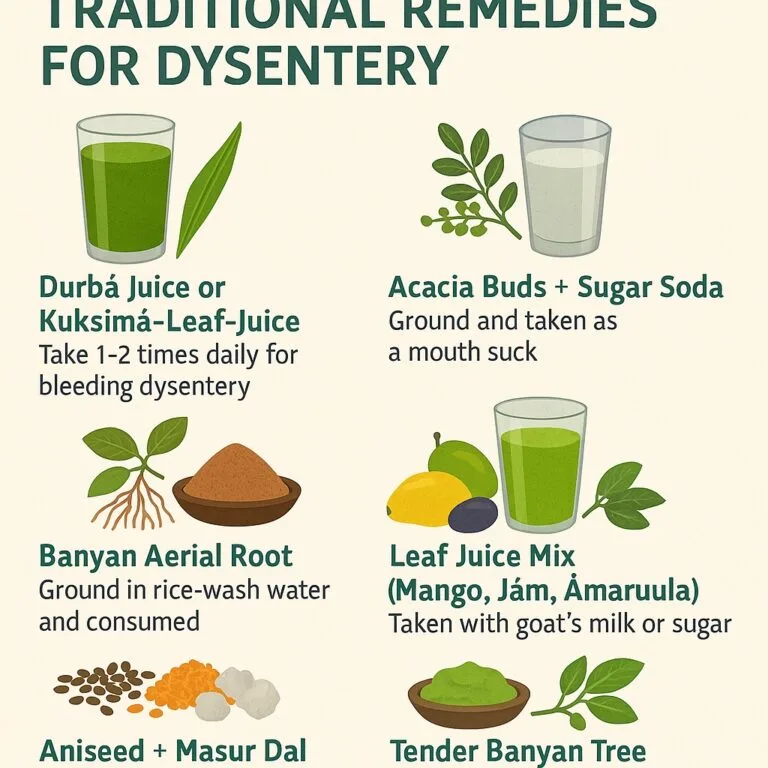🔍 What is Dysentery?
Dysentery is a digestive disorder marked by frequent, small-volume stools often accompanied by mucus or blood, abdominal cramps, and a constant urge to defecate. It is an intestinal infection that primarily affects the colon and is caused by contaminated food, water, or poor hygiene.
In Ayurveda, dysentery is seen as a disorder caused by imbalanced Pitta dosha and weak digestive fire (Agni). Improper digestion leads to fermentation and accumulation of toxins (Ama), causing inflammation and infection in the intestines.
⚠️ Common Symptoms of Dysentery
- Frequent but scanty bowel movements
- Mucus or blood in stool
- Abdominal cramps, especially around the navel
- Painful urge to pass stool
- General weakness and fatigue
🧬 Causes of Dysentery
From a modern and Ayurvedic perspective, dysentery can be triggered by:
- Consumption of half-cooked or contaminated meat and pulses
- Exposure to contaminated air or unclean food
- Weakened digestive fire (Mandagni), making it difficult to digest heavy or unsuitable foods
- Proliferation of harmful bacteria or parasites in the intestines
- Accumulated toxins damaging the intestinal mucous membrane
When the body’s fluid-secreting glands try to correct this internal disturbance, excess fluid mixes with the waste and creates mucus—a natural healing response of the body.
🧘♂️ Recommended Yogic Practices for Dysentery
Morning and Evening Yoga Routine:
- Utkśepa Mudrá
- Padahastásana
- Agnisára Kriyā
- Uddiyana Bandha
- Ágneyii Prāṇāyāma
These practices help in stimulating digestion, strengthening abdominal muscles, and eliminating toxins naturally.
🥗 Ayurvedic Diet for Dysentery Patients
🚫 Foods to Avoid:
- Fried and oily foods
- Pulses and legumes
- Ghee, oil, butter, and other fatty substances
- All types of non-vegetarian foods
- Parched or heavily spiced items
✅ Ideal Diet:
Phase 1 (Initial Relief):
- Citrus water only (orange or tangerine juice with water) for the first 24–48 hours
- Helps cleanse and rest the digestive system
Phase 2 (Recovery Stage):
- Hot boiled rice, rinsed in cold water for 30 seconds
- Light vegetable soup made from:
- Patol (Pointed gourd)
- Gandhala
- Tellakucha (Ivy gourd)
- Thankuni (Centella asiatica)
- Curd-water (better than milk or curd for digestion)
- Roasted bael fruit or ripe banana fried lightly in ghee
- Aged tamarind chutney with ripe bananas (not more than two tolas)
For Chronic Dysentery:
- Dinner before 9 PM
- Hot luchi (puri) with a pinch of salt
- Hot jalebi (jilapii) as a snack or breakfast
✅ Ayurvedic Remedies for Dysentery
1. For Bleeding Dysentery
- Durba grass juice or Kukshima leaf juice
- Take a small quantity morning or both morning and evening
2. For Soothing Relief
- ¼ tola of Acacia arabica bud, ground with batasa (powdered sugar + baking soda)
- Suck slowly for best results
3. Quick Relief Remedies
- Banyan aerial root paste with rice-wash water
- Juice of mango, jamun, and amra (hog plum) leaves with goat’s milk
- Amra leaf juice with sugar on an empty stomach
- Overnight-soaked aniseed + masoor dal + mishri (rock sugar) drink
- Take morning and evening
4. Powerful Leaf Juice Combo
- Juice of mango, jamun, and kayetbel leaves
- Mix with a pinch of salt and drink every morning on an empty stomach
- Add a red-hot iron piece for fever-reducing benefits (traditional remedy)
5. For Chronic Cases
- Banyan tendrils paste with rice-wash water
- Continue for a few days to fully cure chronic dysentery
⚠️ Do’s and Don’ts for Dysentery Patients
✅ Do:
- Keep the abdomen warm, especially during aggravated stages
- Use a flannel cloth to wrap around the belly
- Take curd-water instead of milk for better digestion
- Maintain regular meal timings
❌ Don’t:
- Avoid exposing the abdomen to cold air
- Do not skip meals or leave the stomach empty
- Avoid milk, oily, spicy, and non-vegetarian foods
🌱 Final Thoughts: Natural Healing for Dysentery
Dysentery can be effectively managed and healed through a combination of Ayurvedic diet regulation, natural herbal remedies, and simple yogic practices. Focusing on digestion, detoxification, and intestinal health is key to recovery. Always consult with a qualified Ayurvedic practitioner for personalized guidance.
“Detailed insights into herbal piles cure with traditional practices.”
“Practical tips and diet advice for natural gastric ulcer treatment.”
Frequently Asked Questions :-
Q1. What causes dysentery according to Ayurveda?
Ans: In Ayurveda, dysentery is described as Atisara caused by aggravated Vata and Pitta doshas. Common causes include contaminated food or water, weak digestion, eating incompatible foods, and infection leading to inflammation in the intestines.
Q2. Can Ayurveda cure dysentery naturally?
Ans: Yes, Ayurveda offers effective remedies for mild to moderate dysentery. Herbs, diet regulation, and natural therapies help control diarrhea, reduce abdominal pain, and restore healthy digestion. Severe or chronic cases should be treated with medical supervision.
Q3. Which Ayurvedic herbs are beneficial for dysentery?
Ans: Herbs like Bilva (Bael fruit), Kutaj (Holarrhena antidysenterica), Nagarmotha (Nutgrass), Pomegranate rind, and Musta are commonly used to stop loose motions, reduce infection, and strengthen digestion.
Q4. What diet is recommended for dysentery patients in Ayurveda?
Ans: Ayurveda suggests a light, easily digestible diet such as rice gruel, moong dal soup, pomegranate juice, buttermilk with roasted cumin, and boiled vegetables. Oily, spicy, fermented, and heavy foods should be avoided.
Q5. How can dysentery be prevented according to Ayurveda?
Ans: Preventive measures include maintaining proper hygiene, drinking clean water, avoiding stale or contaminated food, strengthening digestion with herbs like Triphala, and following a balanced diet to keep doshas in harmony.
Trusted External Resources
For more information on Ayurveda, yoga, and natural wellness, explore these authoritative resources:
